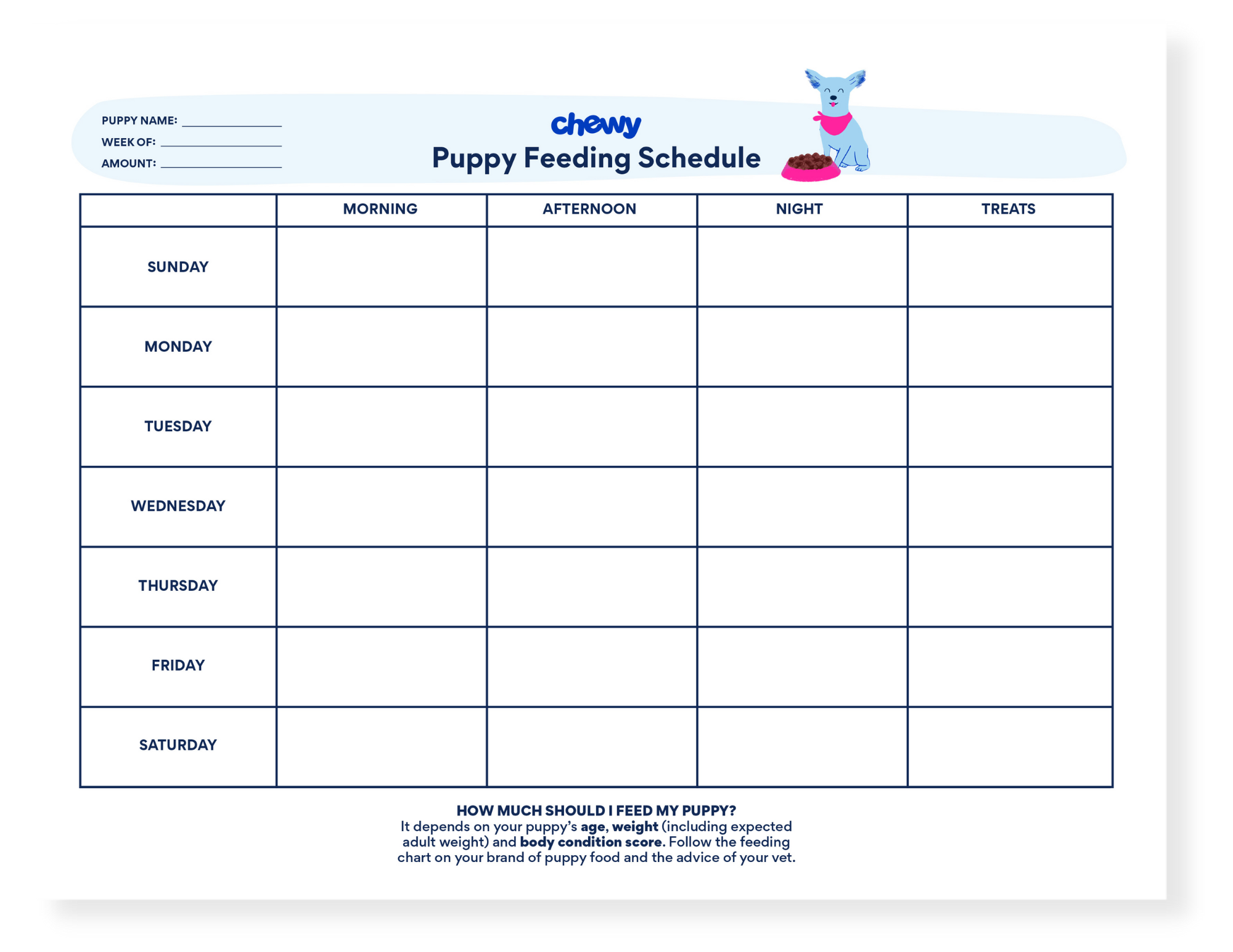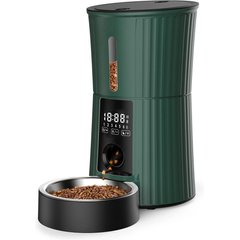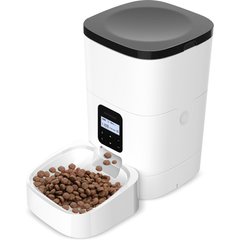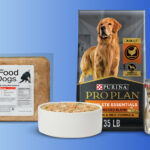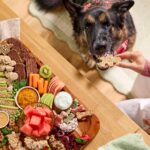How Much Food Should I Feed My Dog?

Photo by Chewy Studios
You are in charge of your dog’s diet and overall health, so it’s natural to ask the question, “How much food should I feed my dog?” The exact answer to this question depends on the type of food you’re feeding and other factors, like your dog’s activity level and specific dietary needs. But experts have come up with general guidelines to make feeding time a little more straightforward.
We talked to two veterinarians to get the scoop on all the different factors that impact how much to feed your dog, and to put together a dog feeding chart that will help you come up with a good baseline. Of course, if you want to get really specific, make sure you’re talking to your own vet to get the exact number of calories your dog should be eating each day.
Key Takeaways
- The amount to feed your dog will vary based on age, breed, activity level, body condition, health status, and more.
- The feeding chart on your food’s bag is a good starting point, but work with your vet to determine the ideal feeding plan for your specific pet.
- While the age and breed of your dog will influence how many times per day to feed them, most adult dogs do well eating twice per day.
- Feeding the right amount of food is important to prevent malnutrition or, more commonly, obesity.
6 Factors That Impact How Much To Feed Dogs
Just like humans have varying nutrition needs, there’s no one-size-fits-all answer to how much you should feed your dog. That’s because how much a dog needs to eat can be impacted by age, breed, activity level, pregnancy, disease, and current weight and body condition score (BCS), says Dr. Sarah Reidenbach, DVM and CEO of Ruthless Kindness in Sebastopol, California.
1. Age
Age is one of the biggest factors in how much food to feed your dog.
“Young, fast-growing puppies need more calories and a different balance of nutrients than older, more mature, or more sedentary dogs,” says Dr. Paul Kline, DVM, CityVet‘s Chief Medical Officer, of Dallas, Texas.
Foods that are labeled for puppies tend to have a different mix of proteins and different caloric makeup than those labeled for mature or senior pets, adds Dr. Kline.
2. Activity Level
Just like with people, dogs have different activity and fitness levels.
For example, “a young, hard-working Labrador Retriever that’s in the field all day chasing ducks will require a much higher intake of food (calories) than an older Pug that spends his day napping in the sun,” says Dr. Kline.
3. Breed
Similarly, a dog’s breed has an impact on their overall energy and food requirements.
This is due to the inherent nature of certain breeds’ temperament, natural activity level and overall metabolic rate, according to Dr. Kline.
For example, breed types such as Basset Hounds, Pugs, Bulldogs and Mastiffs generally exhibit lower activity levels than Border Collies, Boxers or many types of Terrier breeds, Dr. Kline says.
“As a result, resting energy requirements (RER) for lower activity breeds are less than those with higher natural activity levels,” he adds.
4. Neutered vs. Intact
Reproductive status also plays a role.
If your pet has been spayed or neutered, their metabolism tends to slow, “and thus they may require less food intake than if they were still sexually intact,” says Dr. Kline.
5. Current Body Condition
Sometimes the best indicator of a pet’s need for more or less food can be their current body condition, according to Dr. Kline.
“Veterinarians use a system to score body condition that is usually based on a 9-point scale and evaluates overall body fat and weight to determine whether a dog is at a proper plane of nutrition,” he explains.
Dogs who score too low are given more food or better-quality food. And for dogs who score too high, the amount of food (caloric intake) is reduced.
6. Current Health Status
Your dog’s health status also factors into how much they should be eating. Pregnant and nursing dogs have higher calorie demands, so Dr. Reidenbach recommends feeding them a higher-calorie diet.
“Various disease states such as diabetes, cancer, thyroid disease, orthopedic limitations, allergies and more can also impact what an animal needs nutritionally,” Dr. Reidenbach says.
Dog Feeding Chart: How Much Food To Feed My Dog
That being said, general feeding guidelines are often based on ideal weight.
As a general rule of thumb, most dogs will consume 2 to 4 percent of their body weight in food. Smaller dogs skew toward the high end of the scale, while larger, older animals skew toward the low end, says Dr. Kline.
Protein requirements tend to be similar for all dogs and usually is around 1 gram of protein per pound of body weight per day.
Keep in mind that exact nutritional needs will vary based on the factors above, but here are some general daily feeding guidelines for healthy, adult dogs.
| Ideal Weight | Average Calorie Intake |
|---|---|
| 3 pounds | 144 calories |
| 5 pounds | 210 calories |
| 10 pounds | 346 calories |
| 15 pounds | 472 calories |
| 20 pounds | 587 calories |
| 30 pounds | 794 calories |
| 40 pounds | 982 calories |
| 50 pounds | 1,165 calories |
| 60 pounds | 1,334 calories |
| 70 pounds | 1,499 calories |
| 80 pounds | 1,656 calories |
| 90 pounds | 1,808 calories |
| 100 pounds | 1,958 calories |
Use a Calorie Calculator
If you want a more specific recommendation, dog feeding calculators are available online that will take into account various factors such as age, breed, activity level and body condition score, according to Dr. Kline.
If you want to do the math yourself, use the Resting Energy Requirement formula: Multiply your dog’s body weight in kilograms raised to the 3/4 power by 70.
For example, a 10-kilogram (22-pound) adult dog of a healthy weight needs RER = 70(10kg)^3/4 or 400 calories per day, Dr. Reidenbach says.
(Yeah, we’d prefer to use a calorie calculator, too…)
Read the Feeding Guide on the Dog Food Bag
Not all pet foods have the same calorie density. Because of that, it’s also helpful to read the feeding guide on your dog food bag.
Dog food bags generally have specific calorie guidelines that are translated to quantities, so you’ll know exactly how many cups of the food you should be serving.
Of course, you’ll have to consider your dog’s specific lifestyle and health factors and modify the amounts accordingly.
This is the American Journey Protein & Grains Dry Dog Food feeding chart, for example:
| Dog Weight | Cups Per Day |
|---|---|
| 3 | 1/2 |
| 6 | 3/4 |
| 10 | 1 |
| 15 | 1 1/2 |
| 20 | 1 3/4 |
| 30 | 2 1/2 |
| 40 | 3 |
| 50 | 3 1/2 |
| 60 | 4 |
| 70 | 4 1/2 |
| 80 | 5 |
How Much Food To Feed My Puppy
Puppies’ dietary needs differ from those of a full-grown dog. This is because puppies are in a rapid-growth phase, which means their metabolism is high and their need for calories increases, explains Dr. Kline.
Puppy diets also should have the proper blend of nutrients, including vitamins, minerals and protein content, for their life stage.
But exactly how much food you give your puppy depends on their age, weight and body condition score. While there are body condition score charts available online, this is best determined by your vet.
“For puppies 0 to 4 months old, we recommend feeding, on average, three times the resting energy requirements. For puppies 4 to 12 months, we recommend two times the RER. This can vary with breed and individual needs, so it’s important to monitor the dog’s weight and talk to your veterinarian,” says Dr. Reidenbach.
Different puppy foods all have different nutrient densities, so manufacturers’ recommendations will vary from formula to formula. For example, this is the American Journey Active Life Formula Puppy Dog Food feeding chart:
| Puppy Weight | Cups (ages 1.5-6 mos.) | Cups (ages 6-12 mos.) |
|---|---|---|
| 3 | 3/4 | 1/2 |
| 6 | 1 1/4 | 3/4 |
| 10 | 1 3/4 | 1 1/4 |
| 15 | 2 1/2 | 1 2/3 |
| 20 | 3 | 2 |
| 30 | 4 | 2 3/4 |
| 40 | 5 | 3 1/3 |
| 50 | 6 | 4 |
| 60 | 6 3/4 | 4 2/3 |
| 70 | 7 2/3 | 5 1/4 |
| 80 | 8 1/2 | 5 2/3 |
View our Puppy Feeding Guide to learn more about how much and what to feed puppies.
How Much To Feed My Senior Dog
As mentioned, your dog’s age also plays a role in the right amount of food to give. Senior dogs tend to need a lower-calorie diet and less frequent feedings, says Dr. Kline. Typically, this is because their metabolism slows down and they’re not as active. In general, senior dogs should eat about 2 percent of their body weight in calories.
Keep in mind, though, that your dog may start losing weight as they get older. If this happens, you shouldn’t necessarily adjust feeding amounts based on current weight. Instead, you’ll want to work with your veterinarian to come up with the right daily caloric intake based on your dog’s lifestyle and underlying health problems.
It’s also important to note that what’s considered a “senior dog” depends on the dog’s size:
- Small breeds and toy breeds are considered seniors when they’re 11 or 12.
- Medium breeds are considered seniors at 10 years old.
- Large breeds are categorized as seniors at 8 years old.
- Giant breeds are seniors at 7 years of age.
Here’s an example of a dog feeding chart for senior dogs, specifically, from American Journey Active Life Formula Senior Dry Dog Food:
| Dog Weight | Cups Per Day |
|---|---|
| 3 | 1/2 |
| 6 | 3/4 |
| 10 | 1 |
| 15 | 1 1/2 |
| 20 | 2 |
| 30 | 2 1/2 |
| 40 | 3 |
| 50 | 3 2/3 |
| 60 | 4 1/4 |
| 70 | 4 3/4 |
| 80 | 5 1/4 |
Dog Feeding Schedule: How Often To Feed Dogs and Puppies
As for how often you should feed your dog, Dr. Reidenbach says she likes to feed adult dogs twice per day—once in the morning and then again in the evening.
“I find that multiple meals helps to spread out blood sugar spikes and troughs and avoids excessive feelings of hunger. I typically give half of their calories at each meal,” she says.
Puppies need more calories more often, at least at first, so they should be fed more frequently. Dr. Reidenbach recommends feeding them three to four times per day at first, then get them into their twice-per-day routine by gradually reducing the meals that will be eliminated.
Keep in mind that this is a generalization for a typical, healthy dog. Recommendations may vary for working dogs, dogs who are experiencing health issues, or dogs with other individual needs.
How To Manage Your Dog’s Meals
As far as managing feed times, there’s no one-size-fits-all answer here, either. Every dog is unique, and different dogs may thrive with different feeding habits.
“For most healthy dogs without special needs, I’ve found success with a twice per day meal routine,” says Dr. Reidenbach. “They love looking forward to their meal times, and anticipate the joy of their breakfast and dinner. If they’ve exerted themselves more than usual, I’ll add in a treat, and I always make sure they have access to fresh water at all times.”
As for specific timing, you can work that out based on your current schedule and what works for your household. But once you get into a routine, it’s a good idea to stick to it.
Should I Free-Feed My Dog?
Dr. Reidenbach doesn’t recommend free-feeding unless it’s a dog who is a picky eater and prefers to graze and won’t eat sufficient calories in a single sitting.
“More often than not, free-feeding leads to obesity,” she says.
Try Automatic Dog Feeders
If you’re having trouble sticking to a set routine, you can also use an automatic dog feeder that will dispense customized portion sizes up to four times per day.
Automatic dog feeders don’t require you to actively serve your dog, but they can prevent overfeeding that can come with free-feeding.
Keep in mind these only work with dry dog food, though, so if you’re supplementing kibble with wet food, you’ll have to think of another creative solution.
Recommended Products
Why Feeding the Right Amount Is So Important
Feeding the right amount is vital to your dog’s health and quality of life.
“Just like with humans, dogs experience problems with undernutrition as well as with obesity. Other than the obvious discomfort that each condition can cause, there are also damaging physical and physiological impacts,” says Dr. Reidenbach, who explains that:
- Malnutrition can impact growth, strength, the immune system and susceptibility to infection. It can lead to hair loss and fragile bones.
- Obesity can lead to painful arthritis, liver and kidney disease, urinary problems, thyroid problems, heart failure, diabetes, cancer and more.
“A practical consideration is the expense of feeding your pet more than they need. Most dogs would be much better off eating less of a higher-quality diet than eating more of a low-quality, cheap food,” Dr. Reidenbach says. “The old saying, ‘You are what you eat,’ applies just as much to dogs as it does to people.”
